|
|
|
| ||
| Espaņol |
Currently only excerpts & illustrations from the last 13 issues (numbers 43 to 55) are on this site. Scroll down to view the December 1999 issue. Click on the numbers to view other issues. Info about the current book on the arts | |||||||||||||||||||||||||||||||||||||||||||||||
| Contents List | |||||||||||||||||||||||||||||||||||||||||||||||
| excerpts & illustrations (The full articles are only available in the printed magazine. Click on "subscribe" for more info.) |
 |
56 |  |
55 |  |
54 |  |
 |  |
53 |  | 52 |  |
51 |  |
 |
 |
50 |  |
49 |  |
48 |  |
47 |  |
 |  |  |  |
 | ||||||||||||||||||
 |
 |  |
 | ||||||||||||||||||||||||||||||||||||||||||||
| 46 |  |
45 |  | 44 |  |
43 |  |  |
 | 42 |  | 41 |  | 40 |  | 39 |  |
 | 38 |  | 37 |  |
36 |  | 35 |  |
 |  |
34 |  |
33 |  | 32 |  | 31 |  | |||||||||||
number 50
|
 Drawing by TBA in the ABS art exhibition, Gryphon Gallery, Melbourne, Australia, photograph by Kouhyar Rowshan, Australia. | ||||||||||||||||||||||||||||||||||||||||||||||
|
Beyond Words will use as many of the arts as possible---dance, drama,
singing, public speaking, acting... ...Only 12 performers (6 guys and 6 gals) are needed. So, youth eighteen to thirty years of age from around the globe,
interested in doing a year of service, please contact BeyondWords by
e-mail: BeyondWordsWksp@email.com or through the regular post:
Beyond Words, 603 Palo Alto, Knysna Rd., Milnerton 7441, South Africa.
Letters from: | |||||||||||||||||||||||||||||||||||||||||||||||
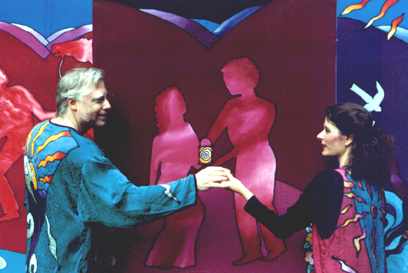
Marty and Wendy Quinn performing in the The Seven Valleys. |
Wendy and Marty Quinn, U.S.A. We are pleased to announce the completion of our 90 minute stage adaptation of Bahá'u'lláh's The Seven Valleys. Designed and tested for professional presentation to the general public, it presents Bahá'u'lláh's mystical work through music, drama, dance, singing, drumming, beautiful silk costumes, sets and calligraphy. Performed by the Quinn family, it is a unique integration of art and performance. | ||||||||||||||||||||||||||||||||||||||||||||||
The Seven Valleys can be compared to other sacred or spiritually based
theatrical productions performed around the world. The tradition of
transferring sacred text, stories and spiritual themes to the stage has
been longstanding in many cultures...
|
|
Cost AUS$33 including postage payable by cheque, money order, or credit card. Orders from the US, Canada or the Caribbean AUS$28, Orders from within Australia: AUS$24. Ryan Telfer, Canada ...My involvement in music has been a significant part of my life and it has really changed me. As a child I have always listened to music. Anything from Bahá´í children's song to the popular music of the 80's... In high school I formed a rock band with my friends and swithced from guitar to bass, which is now my primary instrument. I still play in this band. although we don't do covers, we play almost all original material, which I have helped to compose and write lyrics for... |

Ryan Telfer, Canada. | ||||||||||||||||||||||||||||||||||||||||||||||
|
Letter from Bruce Grover, U.S.A.
In my mind a musician is one who produces a sound that touches the head, heart or hips of a listener. 'Abdu'l-Bahá says that music is a ladder for the soul. We tend to think about this ladder business fairly simply but I think that ladders for the soul take the soul to where it needs to grow. And as we all know, growth can happen in very, very odd ways and very, very odd times. Consequently, avant-garde noise, hardcore punk, blues, salsa, Gregorian chants, ragas and all of Earth's many sound-poems can all be ladders for the soul. Letter from Lindsey Shields, New Zealand. My tour from Dunedin northwards and back again was lovely. You could call it a working holiday, but really there was nothing like hard work about it. I really enjoyed my concerts, the audiences who listened to my stories, the opportunity to share some time and experiences, meeting new people who took the time to talk to me. I learnt that doing what you really like to do is easy, it feels like love, perhaps it is. Surviving financially and doing all sorts of organising feels more like hardwork, less like love! The tour worked so well because I had it organised by someone else, a tour promoter called Gill Winter of Flying Piglets. She did most of the planning and negotiated guaranteed fees for all the concerts. So it really was my job to just go out there and do good concerts, stress-free! That was a key part of its success. On a global scale, in fact, on any scale, this was a small tour. Seven gigs over the space of three weeks and none of the audiences big. I had never played at any of the venues before and had only ever visited one. They moved from a quiet Sunday in an Irish bar, through local halls, one house concert (with a tiny audience) and some folk clubs... I have been feeling very comfortable about my solo performing. Of course there is a certain level of nervousness beforehand, but nothing like the anxiety which has been a great weight holding me down. I think its been a matter of confidence too, which has nothing to do with how "good" your work is, or what other people think of it. Always I would think I needed other musicians around me to make my music okay, or that I should be able to perform in any situation, no matter what - bar, cafe, where ever. Of course, the personal themes in my songs is completely unsuited for those situations so I set about working for my kind of audience - people who want to listen to my stories... Letter from Jan Lopez, U.S.A. Here are a few thoughts on the subjects of artistic perfection, passion and professionalism. Through many years of exposure as a musician, I have come to the conclusion that in this world there are basically three kinds of approaches to any endeavor: (1) technical, (2) passionate, and (3) where that unique individual manages to combine both approaches into their art/work and creates a pure heavenly experience, clear and simple. In other words, there are (1) people who do what they do, and (2) people who are what they do, and (3) then those who are and do what they do. However, I would like to speak here about those of us who fall somewhere between technical and passionate on the scale. Most of us, if we are honest about it, are on the path to one or the other and are hopeful of striking a good balance between the two. In the first, one comes close to perfection in areas of training and application, while in the second, although generally not as perfect in application, one carries a level of energy that in a sense takes the listener or reader into an area of appreciation that doesn't require validation by technical standards. In the third, the art speaks for itself, balanced and beautiful; the artist is just a conduit. There are times when we see/read/hear artists who make "technical mistakes", who do not hit all the notes, who forget or misread lines, who stumble, who design outside the standards: and yet, even though we are aware of all these things, we really do not care at all! Why? Because whatever it is that they did, they caught our hearts and souls. They don't care if they perform to one person or 20,000. Or just the sky itself. The burning passion demands release, so they release it. If any artist is feeling sensitive to comments others make regarding our art forms, then perhaps they need to examine internally what brings up that feeling. We artists sometimes forget that we do not need to compare ourselves to others, and often we just do it automatically, without thinking. Striving for achievement does not have to include putting others down. Nor does it have to do with setting ourselves apart from others. Our art forms will speak to our skills, training and abilities we do not need to make a special effort to seek approval... | |||||||||||||||||||||||||||||||||||||||||||||||
|
Letter from Caroline Ruizeveld, The Netherlands. | |||||||||||||||||||||||||||||||||||||||||||||||
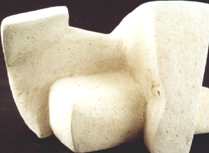
By Caroline Ruizeveld sculpted in Indonesia. |
The third part of my sculpting triglogy ends with working on the island of Bali for 3 months, ending in February 1999.
Each day I travelled by small bus from Ubud, a painter's village, to Batubulan, a long street full of sculputre shops. Here lots
of men sat sculpting between the numerous sculptures of Balinese and Hindu gods and demons. I took my place behind on such
shop, sitting on a cardboard on the damp ground among the mosquitoes. I found the stone very difficult...
...here the stones used for sculpting, cut from a riverbed, were damp, soft, full of holes and not to be trusted... | ||||||||||||||||||||||||||||||||||||||||||||||
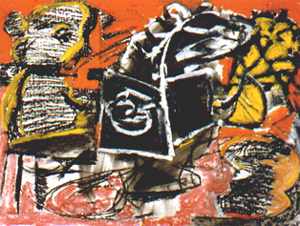
Jack on the box, oil stick and charcoal, 1993, by Dave Taylor, U.S.A. | |||||||||||||||||||||||||||||||||||||||||||||||
Bahá´í artists and friends from the U.S. and Canada gathered in Brackley area,
Prince Edward Island, Canada over the weekend of August 14-15 to attend the first annual
Arts Weekend of the Atlantic Provinces.
|
|||||||||||||||||||||||||||||||||||||||||||||||
|
page 7 North American ABS Conference by Susan Lewis-Wright U.S.A. The Assn for Bahá´í Studies conference this past June in Tempe, Arizone incorporated the arts into it better than any Bahá´í conference I've participated in or attended to date. ...Susan Lewis Wright opened the program singing Don't Laugh At Me, a song depicting the pain of labeling and name-calling. On Friday evening a group from Phoenix performed traditional Turkish dance, singer/songwriter, Susan Lewis-Wright gave a 40 minute concert, and three indigenous Bahá´ís from Alaska , members of the Drums of Light, performed and gave a presentation on the "demystification of the American Indian", which was educational, entertainig as well as painful, as it exposed the racism and oppression fo the native peoples... | |||||||||||||||||||||||||||||||||||||||||||||||
|
pages 7 - 8 The Creative Inspiration, Arts & Culture in the Bahá´í Faith Conference organized in Melbourne, Australia by the Australian Bahá´í Studies Association, held at the Melbourne University, 21st - 26th September 1999. Report from the Association for Bahá´í Studies of Australia. The Association's 18th Annual Conference on the Arts and Culture attracted more than fifty presenters and performers, and approximately a hundred and fifty participants. The conference included workshops and seminars, a dinner, an exhibition, a play, and a concert. Its aim was to provide an opportunity for those involved in the arts in the Australian Bahá´í Community to meet each other so as to become informed of each others' work, to bring the arts to the wider community, and to foster discussion of critical issues facing Bahá´í s in the arts at the present time. The first three days consisted of workshops in drama, the visual arts, creative writing, dance, and music. Sessions were conducted by Jan Coker, Maxien Bradley, Grant Hindin Miller, the Centre Theatre Company, Ruth Park, Artworks Visual Arts Theatre, Greg Parker, Shirin Lagha'i, Kath Podger, Michael Knopf, Ron Price, and Michael Phillips. | |||||||||||||||||||||||||||||||||||||||||||||||
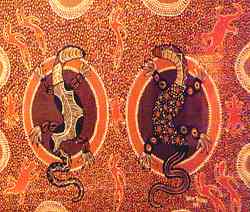
Painting by TBA in the ABS art exhibition, Gryphon Gallery, Melbourne, Australia, photograph by Kouhyar Rowshan, Australia. |
The Visual Arts Exhibition, held in the Gryphon Gallery in the University's splendid 1888 Building, was officially opened on the evening of 23rd September, with a reception and music by the Melbourne choir, "Breezes of Harmony". Over the next three days the work of twenty artists attracted hundreds of visitors. The exhibition included work by J.J.Jannu, Karel Fontaine, Steve & Angela Clark, Vahid Payman, Ruth Park, Chris Reid, Kath Podger, Diane Arjomand, Katayoun Mottahedin, Claus Barabbas Mayrhofer, Anne Williams, Yvonne Chapman, Terry Eichler, Lorni Hyland, Sonja van Kerkhoff, Ebrahim Malekzadeh, Haifa Mehdizadeh, Mehrzad Mumtahan, and Carolyn Newport. | ||||||||||||||||||||||||||||||||||||||||||||||
|
From Friday to Sunday participants chose between forty or so
sessions, almost all focused on the arts. These included
performances and seminars on poetry (Ron Price - "The
Passionate Artist"; Belinda Belton - "Bahá´í Poetry: the
Power of the Word", Narelle Kinneally Tolstoff - "Spiritual
Symphonies"), Literature (Jamshid Fanaian; Camilla Fligelman
"Is it nearly impossible for a mere human being to write a
good work of art with a religious theme?") and Music
(Michael Knopf); artists presentations about their own work
(Kath Podger; Sonja van Kerkhoff, Jan Coker "Mnemonic",
Steve & Angela Clark "Making a living whilst maintaining
artistic integrity - The Artists Dilemma"; Karel Fontaine
"The Creative Impulse: Symbolism and Seeing", Robin
Chandler: This Artist's Life: A presentation of twenty-five
years of life and work as artist, administrator,
sociologist, and CEO as one model to integrate the life of
art into spiritual service & teaching", Monir Rowshan
"Inspiration/Visualisation of Dreams") and thoughts on the
artistic process (Philip Hinton "The Search for the Beloved:
The Artist as Spiritual Voyager", Ben Hinton "An exploration
of the diverse concepts of creativity, imagination, and
inspiration"; Negin Sanaei "Creativity and Spirituality -
are they related?"; Simon Hinton "Will Celine Dion Eat the
World? - Globalisation and The Cultural Marketplace").
There were also papers on the position of the arts in the Bahá´í Community (Mahyar Amjadi "Arts Can Move the Youth"; Bahá´í Institute of Performing Arts "Performance: A Sacred Act", Simon Hinton "Artists, Institutions and Money - An Unholy Trinity? - Arts Funding and Infrastructure Support in the Bahá´í Community"; Robin Chandler "Building Creative Communities: approaching the arts as social & economic development through professionalizing, training, and networking internationally. There were also presentations on other subjects (Sepehr Manuchehri, "The Practice of Taqiah (self-denial) in the Babí & Bahá´í Religions" and Graham Hassall "Current issues in Bahá´í Scholarship"). Neda Rahmani presented "The Asia Pacific Newsreel", and there was a display by fashion designer Afsoon Missaghi. Lunch times were given over to the launching of publications (Michael Knopf "The Paramount Project - New Bahá´í Devotional Songs for Community Singing") and a website (the Victorian Bahá´í Community Website official Launch), and a demonstration of wood carving by South Australian artist Chris Reid. | |||||||||||||||||||||||||||||||||||||||||||||||
|
On the evening of Friday 24th September the Association
presented an evening of performance at Performance - Melba
Hall. Those present were privileged to experience a three
hour program featuring Amir Farid, Artworks, John Grey, Greg
Parker, Alice Chew, Jamshid Hatami, Behzad and Anis
Khoshmashrab, Vafa Ferdowsian, Michael Knopf, Grant Hindin
Miller, Ruth Rowshan and Bernardo Soler (Nougat). Special
thanks goes to Erfan Khadem for assistance at the concert,
and to Master of Ceremonies, Omid Master.
The Conference Dinner attracted more than a hundred guests, who enjoyed an outstanding premier of jazz classics performed by Kylie Richardson, and Grant Hindin Miller's personal journey into the creative life. In the closing session of the conference, Philip Hinton performed his solo play "Portals to Freedom" at RMIT's Kaleide Theatre. |

Wood relief by Chris Reid in the ABS art exhibition, Gryphon Gallery, Melbourne, Australia, photograph by Kouhyar Rowshan, Australia. | ||||||||||||||||||||||||||||||||||||||||||||||
|
Did the conference meet its aims? For new ABS Board member
Vahid Payman the conference exploded a number of stereotypes
sometimes experienced in the Bahá´í community. In
particular he mentioned a middle aged Persian man singing
opera from Mozart's Don Giovanni - who would ever have
thought..., the brilliant fusion of scholarship and art
in the life and work of Robin Chandler, and Narelle
Tolstoff's poetry performance which had eight year old
children and seventy year old adults spellbound (not to
mention those between these two extremes!), and Grant
Hindin-Miller's personal story of search, love, wonder, and
all the other Valleys..."
page 8 Impressions of the ABS arts concert by Kris Bernard-Urrutia, Australia. It opened with Greg Parker doing a couple of ballad-type songs, then Amir Farid, our eighteen year old classical pianist. A wonder boy, from Melbourne did a fifteen minute set of three classical pieces that were just incredible diverse and quite stimulating for the audience as well. A young fellow from Dizzy Dance, Vafa Ferdowsian, gave a good dance performance with a multi-media slide presentation going on the screen behind him, which added a very special effect. Jamshid Hatami sang a couple of well-known classical numbers from opera in Italian, well done and one quite humourous! Another Melbourne Bahá´í, John Grey, who plays trumpet here professionally did an absolutely fantastic jazz medley of Gershwin's Rhapsody in Blue accompanied by a woman on grand piano. The piece lasted about ten to twelve minutes and every moment was different and stunning. He had special caps to put on the trumpet which made it sound like a variety of wind instruments, as the piece was written for piano and a full wind section!! Then to finish Behzad Khoshmashrab and his fourteen year old son Anis did a few lively Russian and Persian violin numbers, with son playing piano and electronic keyboard in accompaniment. Again fantastic. And all this was just the first half of the program!! To start the second half, Ruth Roshan and Bernardo Soler performed playing classical guitar and mandolin together, some lovely pieces with a Latin American - Spanish sound. Then Alice Chew, a beautiful young, ballerina did a very evocative ballet number en pointe called 'Maid of Heaven' to create imagery of the 'maid of heaven' that Baha'u'llah saw in the Siyal Chal. Michael Knopf followed with two guitar pieces. It was just incredible to see how his fingers flew move so magically up and down the neck of guitar. Grant Hindin Miller followed with a few songs. He was so well loved here and played so beautifully that people virtually would not let him leave the stage. Of course, last but certainly not least came Artworks. With new numbers and more even more variety of dance and music in the show... | |||||||||||||||||||||||||||||||||||||||||||||||

Costume by Karel Fontaine in the ABS art exhibition, Gryphon Gallery, Melbourne, Australia, photograph by Kouhyar Rowshan, Australia. |
pages 8 - 9 Two workshops and a session at the ABS arts conference by Michael Knopf, Australia For the Paramont Project Workshop about 20 people learned to read basics quickly and we went through about 11 songs. I presented the Cheve system of rhythm language for notation. Each note has its own syllable... ...We learned each piece by reviewing its rhythm using Cheve, its melodic pitches using Solfa , and then the text was added and practised until learned. The aim of the workshop was to make the group independent of a teacher. We broke into smaller groups each of which had the task to learn a new song on their own with only a little help from the facilitator. Most groups got most of their songs correct after having only a rudimentary introduction to the systems used... | ||||||||||||||||||||||||||||||||||||||||||||||
|
My presentation, ´On the Edge of Failure´ reflected the risk
taken by spontaneous creators (such as Jazz improvisationists and free
improvisation proponents) in creating something meaningful for audiences...
Demonstrations of spontaneous composition were conducted on the classical guitar using jazz, classical, flamenco techniques and drumming sounds... page 9 |
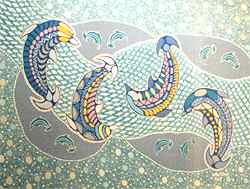
Painting by TBA photograph by Kouhyar Rowshan, Australia. | ||||||||||||||||||||||||||||||||||||||||||||||
|
Book Review, The Seven Year Hitch - A family Odessy
by David R. Grant reviewed by Carolyn Sparey-Gillies, U.K. In an age where travel is associated with holidays in the sun, cheap flights to Disneyland, and for the more adventurous, organised hikes through the Himalayas, "The Seven Year Hitch" proves that the human spirit is still occasionally driven by a sense of adventure and the unknown. This book is the story of some of the adventures which befell us during our seven years travelling around the world with our horses and caravan, the author, David Grant, begins his preface; he goes on to explain that the primary purpose of the trip was to give his children a wide look at the world they will inherit, in the hope that experience of different places, peoples and cultures will enable them to become more understanding, caring, tolerant and wiser citizens of it than if they had simply slogged through the National Curriculum. The children, being 10, 9 and 6 respectively when the adventure began in 1990, fill the pages of this book with their extraordinary achievements and their ability to be responsible in situations which most of us will never even dream of. Their resilience is matched by the horse, Traceur, who managed to pull the caravan more than half way across the world, despite various mishaps and several bouts of ill-health; his unspoken story threads its way through most of the book, until the reader is thoroughly captivated by his enormous spirit and individual personality. David Grant carries his reader, day by day, mile by mile, through the beautiful highways and bye-ways of our planet, moving ever eastwards across Holland, France, Italy, Austria, Hungary and the Ukrain, towards Russia, Kazakhstan, Mongolia, China, and the great Pacific beyond. At times joined by his wife, Kate, who was unable to accompany her family for the entire seven year trip, David not only saw to the day to day business of keeping his family fed, washed and warm, but also found himself, at times, bureaucracy which only superhuman patience and a stream of local heroes helped him through. It was while passing through Mongolia in 1995 that David met some Bahá´ís and made the decision to become a Bahá´í himself; My best memories of Mongolia, he writes, were and remain the warmth, simple sincerity and decency of most Mongolians, in one of the most beautiful countries I have ever seen. Personally, the highpoint of our eleven months there was my acceptance of the Bahá´í Faith. A recognition rather than a conversion... Here, then, is a travel book with a difference; adventure, intrigue and suspense fill the pages alongside poetic descriptions of the landscape, and the every-day problems of simply staying alive. David Grant's panoramic view of the world, experienced from grass-root level, is readable, fascinating,and often humorous; in his own words, we discovered that the world is full of a truly remarkable number of kind, warm-hearted and decent people. Yet nearly all of them ... not excluding ourselves ... come equipped with a baggage of in-built preconceptions, misconceptions and frequently prejudices. In dedicating thisbook to my family, our three gallant horses and the three dogs, I hope that in a small way, which is the only way possible for most people, we did something towards breaking down those barriers and increasing understanding and harmony. The Seven Year Hitch -A Family Odyssey by David R. Grant, published by Simon & Schuster, ISBN 0-684-85802-9 | |||||||||||||||||||||||||||||||||||||||||||||||
|
pages 9 - 10 Gallery as Tabula Rasa Site specific installation by Karnik at the Cafe Gallery, London, U.K. Review by Michèlle Fuirer, U.K. | |||||||||||||||||||||||||||||||||||||||||||||||
...Karnik has made a series of highly charged, playful, interconnected site
specific works. Debris, ephemera, leftovers, scraps and scrapings, dirt and
pigment, carrier bags and cheap paper, have been installed in the gallery
space in various guises. Striding paper figures, bird forms,
dogs, shadows, ropes and lines range through the space.
|
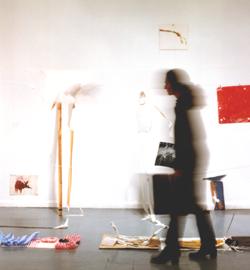
| ||||||||||||||||||||||||||||||||||||||||||||||
In spite of what the chosen
materials may suggest, the process operates far more by design than by
accident. Each work in the exhibition connects, both to site and to each
other, juxtaposition and coincidence is carefully contrived to make an
ensemble...
| |||||||||||||||||||||||||||||||||||||||||||||||

Bird in search of a cage,
detail of the site specific installation, Tabula Rasa by Karnik, Cafe Gallery, London, U.K. 1998. |
...Opposite, in ´a cage in search of a bird´, a dead blackbird is hunched in a
chrome cage. Next to it, simply pinned to the wall, is another bird. Dry,
wizened, miniature, every fine detail of its feathers and
talons take on the
quality of a soft drawing. Alongside, some frenzied and
heavily gouged marks in the plaster have struck through to
the bricks beneath. The text cage
in search of a bird is scored into the wall. This scratching is an
intrusion: the skin of the building has been pierced. The suggestion of
pain, rage, frustration, or of the desire to despoil, to break open or
rupture the surface, suggests a mischievous willfulness that could be
dangerous to know...
| ||||||||||||||||||||||||||||||||||||||||||||||
A battered portfolio
mounted on a pulley invites us to give its handle a tug, this action
activates a drawing to move in the opposite direction on
the line above...
| |||||||||||||||||||||||||||||||||||||||||||||||
|
CD: Bahá'u'lláh's Way: A Song Cycle
The Doug Shaffer Project by Lynne Rach, U.S.A. The ´song cycle´ part of the title is a clue to the journey the listener will undertake in hearing the songs in order. The title track, ´Bahá'u'lláh's Way,´ leads off like a teacher unveiling the light to a seeker. Then follows ´Traceless Friend,´ which musically reminds one of something that might have been performed by Sting, where the listener bears witness to the seeker´s first steps in search for the Beloved. |
 | ||||||||||||||||||||||||||||||||||||||||||||||
| Subsequent songs admonish the seeker to be steadfast (´Don't Be Foolish´), to persevere (´Shorten These Days´), to keep focused on the horizon (´Mountain Rising´), and to struggle for spiritual life (´Release Me´). The solution to the struggle is revealed in "Turn to the Light," after which the goal is visible in "New World in This World." The awakened soul travels though a very jazzy ´Walk Through This World Together´ before reaching the best song on the CD, ´Just One,´ which advises: Try your very best, hold the note you sing, hold it while others take a breath of spring, sing it by the river where God passed by, it's all just one sweet lullabye... | |||||||||||||||||||||||||||||||||||||||||||||||
Artist Profilepages 11 - 13 Jeremy Martin, singer/songwriter, New Zealand. |

Jeremy Martin. |
At present I am working as a soloist, singing and playing acoustic guitar.
My style has developed in such a way that I work more with vocal rather than
instrumental improvisation. The songs on my latest album are concise
recordings of the material in my songs, but my live performances develop the
improvisational moment more, with the audience.
| ||||||||||||||||||||||||||||||||||||||||||||||
|
One way that my songs come to me is by my crafting a particular moment,
story or image into song, a process that can mean months of development. One
example of this process is my Dream Song. In 1998, while working on my
previous album, I set about writing a song cycle. I wanted each song to
stand in its own right, and the progression of songs to have meaning as
well. I used an arbitrary modulation scheme, with each song alluding to the
musical ideas of the previous and following songs, to give a subconscious
sense of connectedness within the whole cycle. Some melodic themes also
appear in different guises throughout the cycle. The cycle moved through
group experience, to personal experience, then spiritual, mythical and
transpersonal experience and finally returning to the group, community and
family... |
Poemspage 13 Dance by Scott Cudmore, Canada an excerpt Make no mistake, daughter When you dance upon the Earth It stops your feet by pushing you back hard. One of Newton´s Laws of Motion says You exert a force back upon the Earth and The Earth moves. ... |
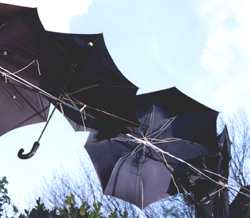
Just in case, detail of Tabula Rasa, installation by Karnik in Cafe Gallery, London, U.K., 1998. | ||||||||||||||||||||||||||||||||||||||||||||||
|
Twelve Strawberries on a Terra-cotta Plate:
A Mediatation by Cal E. Rollins, U.S.A. ...but the Son of man hath not where... Matt 8:20 They rest on a cherry table, polished, old, its body bowed like a corseted lady. Lemon wall and curtains, softer yellow, move together in the open window. Yellow cat eyes stare in the shadow where the berries are cool. In another life, I pluck their stems, feed them one by one. Hold the cup too, know it better, drink deeper than all others. I pull down the sky as a coverlet for the Son of man, scattering, foxes and birds; soothe that sweet brow; play on my lyre the music that bridges peace at this time of day when air is cooling. from No Roosters in This Blue City, 1999, Kalimat Press, U.S.A. |
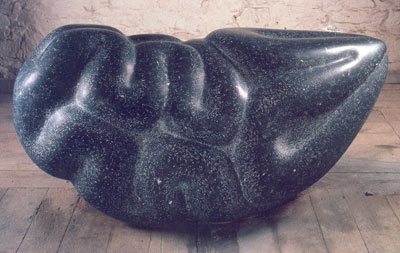
Beneath the Skin, 1991, Kilkenny limestone sculpture by Peter Randall-Page U.K. | ||||||||||||||||||||||||||||||||||||||||||||||
| |||||||||||||||||||||||||||||||||||||||||||||||
|
Translations, editing, layout, by: |
|
Arts Dialogue, Dintel 20, NL 7333 MC, Apeldoorn, The Netherlands
http://Bahá´í-library.org/bafa email: bafa@bahai-library.com |